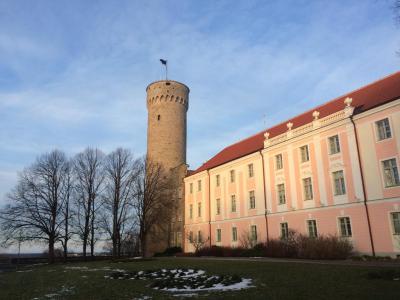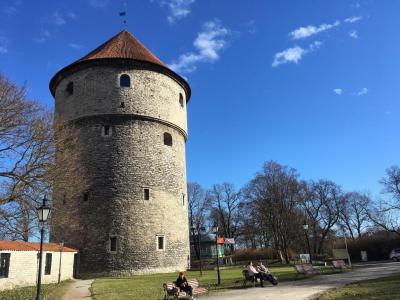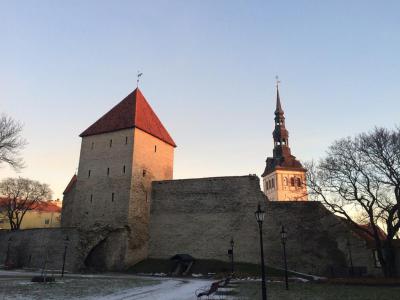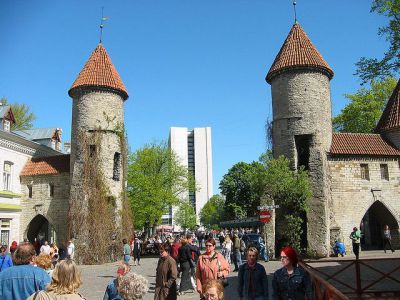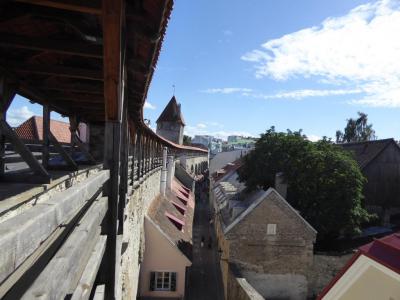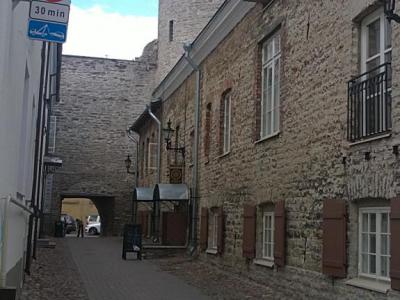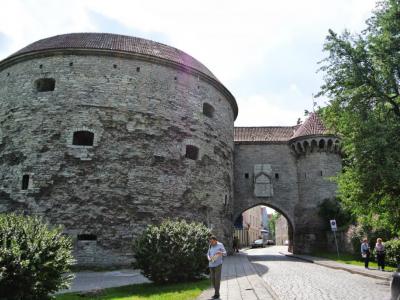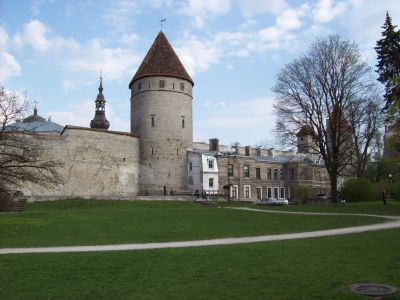Tallinn Old Towers and Gates (Self Guided), Tallinn
Once Europe's greatest fortified city, Tallinn had 46 defense towers and approximately 4 kilometers of surrounding walls. Today, there are 26 towers and about 2 kilometers of walls still in place, making the Old Town of Tallinn one of the best-preserved systems of medieval fortifications in Europe.
Upon entering the district through the Viru Gate, whose two picturesque, ivy-covered towers symbolize the city, one can't help thinking that the 21st century is left behind and we're back in the Middle Ages. The gate's German name Lehmpforte translates as “clay gate” and was due to the clay pits located nearby.
The three ancient towers still open to the public include Nunna (the Nun’s Tower – named after the Cistercian Order located to the north in St. Michael's Convent), Sauna (named after the sauna at St. Michael's), and Kuldjala Torn (the Golden Foot Tower).
Among the other towers worth checking out are:
Pikk Hermann (Tall Hermann) – enlarged under the Teutonic rule in the late 14th century; further lengthened by 10 meters in the 16th century.
Kiek in de Kök – the mightiest bastion in Tallinn, first built in 1475-1483. The name translates from Low German as a “peep (or peek) into the kitchen”.
Neitsitorn (Maiden Tower) – aka “Meg(h)ede torne” in Low German, presumably after a Tallinn citizen named Hinse Meghe.
Hellemann Tower – perhaps one of (if not the) most picturesque; was extensively used during the Soviet era as a shooting set for historical movies.
Next to the Hellemann is Munkadetagune Torn (the Tower behind the Monks) – named so for its location behind the former Dominican monastery of Catherine.
To explore these and other magnificent towers and historic gates of Old Tallinn in more detail, take this self-guided walking tour.
Upon entering the district through the Viru Gate, whose two picturesque, ivy-covered towers symbolize the city, one can't help thinking that the 21st century is left behind and we're back in the Middle Ages. The gate's German name Lehmpforte translates as “clay gate” and was due to the clay pits located nearby.
The three ancient towers still open to the public include Nunna (the Nun’s Tower – named after the Cistercian Order located to the north in St. Michael's Convent), Sauna (named after the sauna at St. Michael's), and Kuldjala Torn (the Golden Foot Tower).
Among the other towers worth checking out are:
Pikk Hermann (Tall Hermann) – enlarged under the Teutonic rule in the late 14th century; further lengthened by 10 meters in the 16th century.
Kiek in de Kök – the mightiest bastion in Tallinn, first built in 1475-1483. The name translates from Low German as a “peep (or peek) into the kitchen”.
Neitsitorn (Maiden Tower) – aka “Meg(h)ede torne” in Low German, presumably after a Tallinn citizen named Hinse Meghe.
Hellemann Tower – perhaps one of (if not the) most picturesque; was extensively used during the Soviet era as a shooting set for historical movies.
Next to the Hellemann is Munkadetagune Torn (the Tower behind the Monks) – named so for its location behind the former Dominican monastery of Catherine.
To explore these and other magnificent towers and historic gates of Old Tallinn in more detail, take this self-guided walking tour.
How it works: Download the app "GPSmyCity: Walks in 1K+ Cities" from Apple App Store or Google Play Store to your mobile phone or tablet. The app turns your mobile device into a personal tour guide and its built-in GPS navigation functions guide you from one tour stop to next. The app works offline, so no data plan is needed when traveling abroad.
Tallinn Old Towers and Gates Map
Guide Name: Tallinn Old Towers and Gates
Guide Location: Estonia » Tallinn (See other walking tours in Tallinn)
Guide Type: Self-guided Walking Tour (Sightseeing)
# of Attractions: 9
Tour Duration: 2 Hour(s)
Travel Distance: 2.8 Km or 1.7 Miles
Author: leticia
Sight(s) Featured in This Guide:
Guide Location: Estonia » Tallinn (See other walking tours in Tallinn)
Guide Type: Self-guided Walking Tour (Sightseeing)
# of Attractions: 9
Tour Duration: 2 Hour(s)
Travel Distance: 2.8 Km or 1.7 Miles
Author: leticia
Sight(s) Featured in This Guide:
- Pikk Hermann (Tall Hermann Tower)
- Kiek in de Kök Museum and Bastion Tunnels
- Maiden Tower (Neitsitorn)
- Viru Gate (Viru Värav)
- Hellemann Tower and City Wall
- Munkadetagune Torn (Tower behind Monks)
- Bremeni Torn (Bremen Tower)
- Great Coastal Gate, Fat Margaret's Tower and Maritime Museum
- Nunna, Sauna and Kuldjala Towers (Town Wall)
1) Pikk Hermann (Tall Hermann Tower)
This location is called Pikk Hermann or the Tall Hermann Tower. It is located at Toompea Castle in Tallinn, Estonia, on the hill that carries the same name. It is situated next to the Estonian Parliament building. The flag of Estonia always flies here on the tower, which reaches up 95 meters into the air at the top of the flag pole. The original structure was begun in 1360, and ended up taking a whopping 40 years to complete. Later, the height of the tower was increased to 45 meters in the 16th Century.
The tower itself consists of ten floors, along with a viewing platform. A total of 215 stairs were added to allow access to all floors, including the viewing platform. During the raising of the flag of Estonia here each day, you can hear the National Anthem played. This typically happens at sunrise, but never occurs earlier than 7:00 a.m. The same event takes places around 10:00 p.m. each evening. The song played is called “My Fatherland is My Love.” So, you get a real chance to see a bit of local patriotism here at the Tall Hermann Tower. It is also fun to go and see the local Parliament Building next door.
The tower itself consists of ten floors, along with a viewing platform. A total of 215 stairs were added to allow access to all floors, including the viewing platform. During the raising of the flag of Estonia here each day, you can hear the National Anthem played. This typically happens at sunrise, but never occurs earlier than 7:00 a.m. The same event takes places around 10:00 p.m. each evening. The song played is called “My Fatherland is My Love.” So, you get a real chance to see a bit of local patriotism here at the Tall Hermann Tower. It is also fun to go and see the local Parliament Building next door.
2) Kiek in de Kök Museum and Bastion Tunnels
The phrase “Kiek in de Kok” derives from German, meaning "Peep into the Kitchen". Kiek in de Kök was an old artillery tower. Occupants of the tower used to be able to peek down into the kitchens of nearby homes, hence the name.
The tower was built in 1475 as part of the impressive fortifications that used to surround the town. It stands an impressive 38 meters high, and is made with walls that are 4 meters thick, which were designed to stand up against canon fire. Today you can still see old cannon balls that are embedded into the walls of the tower that date all the way back to the 16th century.
The old tower has been modified many times during its lifetime. In the 17th Century new gun holes were made at the top of the tower. The structure fell out of use by 1760. For a while, it became a repository for archives and was used briefly as apartments.
Today, the tower is a museum for the town’s fortification system with displays showing how the city's system of walls and towers developed through the centuries as well as other facets of life in old Tallinn. From the museum, one can also enter the Bastion tunnels, dating back to the 17th to 18th centuries, are an integral part of the city’s defense system.
The tower was built in 1475 as part of the impressive fortifications that used to surround the town. It stands an impressive 38 meters high, and is made with walls that are 4 meters thick, which were designed to stand up against canon fire. Today you can still see old cannon balls that are embedded into the walls of the tower that date all the way back to the 16th century.
The old tower has been modified many times during its lifetime. In the 17th Century new gun holes were made at the top of the tower. The structure fell out of use by 1760. For a while, it became a repository for archives and was used briefly as apartments.
Today, the tower is a museum for the town’s fortification system with displays showing how the city's system of walls and towers developed through the centuries as well as other facets of life in old Tallinn. From the museum, one can also enter the Bastion tunnels, dating back to the 17th to 18th centuries, are an integral part of the city’s defense system.
3) Maiden Tower (Neitsitorn)
The Maiden Tower is another of the old towers that were located along the old fortified walls of the Old Town. It is not very far from Town Hall or its sister structure, the Kiek in de Kok. Both of these towers date back to the 14th century, and have been part of city's defensive system for many years.
The Maiden Tower has suffered from the damage of war on many occasions in its history, and you can see some of the canon damage upon close inspection. It has undergone repair in almost every century since.
One interesting fact about the tower is that it was used as a prison for prostitutes, which is why it is called the Maiden Tower. In fact, local legend states that some of the old prisoners still haunt the structure. On a clear dark night, you might be able to see the lights of some old ghost roaming the stairs.
The Maiden Tower has suffered from the damage of war on many occasions in its history, and you can see some of the canon damage upon close inspection. It has undergone repair in almost every century since.
One interesting fact about the tower is that it was used as a prison for prostitutes, which is why it is called the Maiden Tower. In fact, local legend states that some of the old prisoners still haunt the structure. On a clear dark night, you might be able to see the lights of some old ghost roaming the stairs.
4) Viru Gate (Viru Värav)
At one point in time, there were a total of 45 towers built into the walls that protected Tallinn. Twenty-six of those still remain. Two of the best preserved of the bunch are called Viru Gate. The gate dates from the 14th Century, as do most of the towers, and sits at the entrance way into the Old Town.
Today the two towers are quite lovely, having been covered in ivy over the years. It gives a gentle look to Viru Street. When you first enter the Old Town through the gate, it makes you feel as though you have stepped back in time.
The towers used to be the fore gates to the city, and a larger set was built a little further in, which were held up by a set of square towers. Most of the gate was pulled down in 1880, in order to make room for more street traffic. Since that time, though, the two towers have become a symbol for the Tallinn Old Town, which used to be the most fortified city in all of Europe back in the day.
Today the two towers are quite lovely, having been covered in ivy over the years. It gives a gentle look to Viru Street. When you first enter the Old Town through the gate, it makes you feel as though you have stepped back in time.
The towers used to be the fore gates to the city, and a larger set was built a little further in, which were held up by a set of square towers. Most of the gate was pulled down in 1880, in order to make room for more street traffic. Since that time, though, the two towers have become a symbol for the Tallinn Old Town, which used to be the most fortified city in all of Europe back in the day.
5) Hellemann Tower and City Wall
Parts of Tallinn's City Wall have stood since the 13th century. This wall was one of the strongest defense systems in Northern Europe. At its peak, the wall had 45 wall and gate towers and was over two and a quarter kilometers long. Today, 26 towers and less than two kilometers of the wall remain.
The Hellemann Tower was built in the early 15th century. It was named after a resident who owned land nearby and was built to protect Viru Gate. Helleman Tower has three levels and a three quarter circle layout. The 11 meters (33 feet) tall first floor was used as an ammunition room. The tower has also been used as a prison.
Today, Helleman Tower houses an art gallery and offers wonderful views of Town Hall and the rest of Tallinn.
Visitors can also walk along a 200 meter (656 feet) section of the City Wall. This is the longest portion of the wall that is open to visitors. It's surprisingly high up; visitors can see the city streets below and be transported back through the centuries.
The Hellemann Tower was built in the early 15th century. It was named after a resident who owned land nearby and was built to protect Viru Gate. Helleman Tower has three levels and a three quarter circle layout. The 11 meters (33 feet) tall first floor was used as an ammunition room. The tower has also been used as a prison.
Today, Helleman Tower houses an art gallery and offers wonderful views of Town Hall and the rest of Tallinn.
Visitors can also walk along a 200 meter (656 feet) section of the City Wall. This is the longest portion of the wall that is open to visitors. It's surprisingly high up; visitors can see the city streets below and be transported back through the centuries.
6) Munkadetagune Torn (Tower behind Monks)
The Tower behind Monks is located in the Old Town and is part of the medieval defensive structures of Tallinn. Today it is located at the crossroads of Müürivahe and Munga streets, sandwiched between the Bremen Tower and the Helleman Tower. The Tower behind Monks was named due to its location behind the former Dominican monastery of Catherine.
Until the end of the 18th century, the tower housed an ammunition depot, which is why in the 17th century it was popularly called the Tower of Ignition Cords. The tower has been burned repeatedly in its history, most recently in 1994.
During 1970s-1980s, the tower was restored and a café was opened in it. After the 1994 fire, it stood empty for some years, but after a renovation was completed in 2010, the tower is again open to visitors.
Until the end of the 18th century, the tower housed an ammunition depot, which is why in the 17th century it was popularly called the Tower of Ignition Cords. The tower has been burned repeatedly in its history, most recently in 1994.
During 1970s-1980s, the tower was restored and a café was opened in it. After the 1994 fire, it stood empty for some years, but after a renovation was completed in 2010, the tower is again open to visitors.
7) Bremeni Torn (Bremen Tower)
The Bremen Tower is a four-story horseshoe-shaped tower that a defensive tower of the medieval city wall. The tower was built in the early 15th century and named after a someone who lived nearby.
The two lower floors were used as the city's prison until the 17th century. The prison is an unlit room with small air vents and a toilet with iron rings on the walls. Gunpowder was also kept the lower floor during the 18th century.
The two upper floors were defensive floors, which could be accessed from the city wall. The top floor of the tower had a open platform typical for such tower. In peacetime, the tower had a protective roof.
During the WWII, the fortification of the upper floor of the tower was destroyed and the restoration was completed in 1959. Today the tower is open to visitors.
The two lower floors were used as the city's prison until the 17th century. The prison is an unlit room with small air vents and a toilet with iron rings on the walls. Gunpowder was also kept the lower floor during the 18th century.
The two upper floors were defensive floors, which could be accessed from the city wall. The top floor of the tower had a open platform typical for such tower. In peacetime, the tower had a protective roof.
During the WWII, the fortification of the upper floor of the tower was destroyed and the restoration was completed in 1959. Today the tower is open to visitors.
8) Great Coastal Gate, Fat Margaret's Tower and Maritime Museum
If you take a trip down to the sea along Pikk Street in Tallinn, you will find two of the remaining 26 defensive towers for the city. They are the Great Coastal Gate (Suur Rannavärav) and Fat Margaret Tower (Paks Margareeta). They were designed to protect the city from seafaring invaders, as well as impress visitors that would have arrived in the city by the sea. The message they portrayed was clear: don’t even think about attacking the city from the sea.
The Great Coastal Gate is one of six remaining gates that are still intact from the old city wall system. They controlled access to the city during medieval times. This particular gate was added during the 14th century. Fat Margaret Tower was added during the 16th century, while improvements were being made to the fortifications. It was built from 1511 until 1530, and rose 25 meters above the surrounding area. The Great Coastal Gate and tower have walls that are actually a little thicker than most of the surrounding structures. They measure up to 5 meters thick. (The average thickness of the city walls is 3 meters.)
The origins of Fat Margaret's name are not well known. The best conjecture is that the tower was named for one of its larger cannons, while others hint at a cook called Margaret who once cooked for the troops that stood guard. Visitors should take a moment and climb to the top of the tower to get one of the best views in town.
Today the Estonian Maritime Museum is located in the Fat Margaret Tower. The Museum is a very popular tourist attraction in Tallinn. The institution puts on display the history of the ships of Estonia, as well as related information on what sea life was like on the Baltic. There are old tools on display here, as well as other Maritime objects. Some of the old objects here were original bone tools made before the time of Christ. So, you will not want to miss them.
The Great Coastal Gate is one of six remaining gates that are still intact from the old city wall system. They controlled access to the city during medieval times. This particular gate was added during the 14th century. Fat Margaret Tower was added during the 16th century, while improvements were being made to the fortifications. It was built from 1511 until 1530, and rose 25 meters above the surrounding area. The Great Coastal Gate and tower have walls that are actually a little thicker than most of the surrounding structures. They measure up to 5 meters thick. (The average thickness of the city walls is 3 meters.)
The origins of Fat Margaret's name are not well known. The best conjecture is that the tower was named for one of its larger cannons, while others hint at a cook called Margaret who once cooked for the troops that stood guard. Visitors should take a moment and climb to the top of the tower to get one of the best views in town.
Today the Estonian Maritime Museum is located in the Fat Margaret Tower. The Museum is a very popular tourist attraction in Tallinn. The institution puts on display the history of the ships of Estonia, as well as related information on what sea life was like on the Baltic. There are old tools on display here, as well as other Maritime objects. Some of the old objects here were original bone tools made before the time of Christ. So, you will not want to miss them.
9) Nunna, Sauna and Kuldjala Towers (Town Wall) (must see)
The Nunna, Sauna, and Kuldjala Towers are three of the remaining 26 towers that surround the Old Town of Tallinn. In the late 14th century, a massive project was started to build a fortified wall around the city to protect against invaders. By the 16th Century, the walls were raised to sixteen meters high with a thickness of 3 to 4 meters. This made it possible to defend against canon fire. During the 16th century, Tallinn was one of the most fortified cities in the entire world. The wall stretched 4 kilometers around old Tallinn.
These three towers are among the few that are still open to the general public. Visitors can come and walk through all three. In addition, there are some connection paths that are adjacent to the historic standing walls. It gives you a real sense of what the old town was like. Climbing the towers also gives you a great view of the city. You can imagine what it was like to be a guard on the towers. Admission is free.
These three towers are among the few that are still open to the general public. Visitors can come and walk through all three. In addition, there are some connection paths that are adjacent to the historic standing walls. It gives you a real sense of what the old town was like. Climbing the towers also gives you a great view of the city. You can imagine what it was like to be a guard on the towers. Admission is free.
Walking Tours in Tallinn, Estonia
Create Your Own Walk in Tallinn
Creating your own self-guided walk in Tallinn is easy and fun. Choose the city attractions that you want to see and a walk route map will be created just for you. You can even set your hotel as the start point of the walk.
Tallinn Introduction Walking Tour
Estonia’s capital Tallinn is the country’s largest city and cultural hub. One of the biggest ports on the Baltic Sea, the area has been known for its convenient harbor since as early as the 10th century. Owing to its strategic location for trade between Russia and Scandinavia, the Kingdom of Denmark laid claim on this land in 1219. The city itself, first mentioned in 1154, was incorporated in... view more
Tour Duration: 2 Hour(s)
Travel Distance: 4.1 Km or 2.5 Miles
Tour Duration: 2 Hour(s)
Travel Distance: 4.1 Km or 2.5 Miles
Tallinn Medieval Old Town
The Old Town of Tallinn is a UNESCO World Cultural Heritage site since 1997. The area emerged in the 13th-16th centuries when Tallinn was an active member of the Hanseatic trade league, slowly evolving into an enclosed district of colorful, ancient gabled houses, medieval towers and gates, half-hidden courtyards, and ostentatious churches.
Today it is one of the best preserved medieval towns in... view more
Tour Duration: 2 Hour(s)
Travel Distance: 1.7 Km or 1.1 Miles
Today it is one of the best preserved medieval towns in... view more
Tour Duration: 2 Hour(s)
Travel Distance: 1.7 Km or 1.1 Miles
The Most Popular Cities
/ view all



